
Are you thinking about curb appeal, wanting to clean up the planting beds along your home’s foundation?
Did you just add a deck, and the yard around it looks bare and forgotten?
Does your back yard have a pretty garden space left over from the former owners, but now it looks messy and unfinished?
We all have spaces in our yards that we wish looked professional! I see so many homes with just a few plants scattered in a foundation planting bed, or giant shrubs lined up like soldiers around a patio. The yard looks unfinished, sparse, and lacking any power.
Landscapes with planting beds that have been professionally designed look full and lush, while also clean and finished – not crazy! They have a layered look that adds dimension and depth, and the beds are sized appropriately for the surroundings. This is what all my clients show me when I ask for images that have inspired them- full beds with mature plants and no holes.
How can you make this work in your own landscape? Clean edges. Clean edges tidy up any garden space, and one bulletproof solution for clean edges is LOW-GROWING SHRUBS. Here’s why:
-
Low-growing shrubs are… well, shrubs. Not perennials, Not groundcovers. They don’t need to be cut back in the fall, they aren’t bare in early spring. They really don’t change. For a gardener who wants to putter around, they’re kinda boring! But – for a busy family who wants a lovely yard, they are solid. gold. Low-growing shrubs are the definition of low maintenance: set it and forget it. You don’t have to prune or fuss with them at all.
-
These plants keep weeds down. The ones I suggest grow densely, so they shade out anything beneath them. Weeds need light to germinate and grow, and these babies don’t give weeds a chance. Often in a perennial bed, weeds take over because the perennials are small in springtime and weeds get the sunlight they need. But low-growing shrubs will leaf out early (or be evergreen!) and block out those pesky weeds.
-
They’re cost-effective. Shrubs are usually a bit more pricey than perennials, but you’re getting a more robust plant that adds interest throughout the seasons, not a one-hit bloom time. Check out my list to see suggestions that will bring a full, lush look to your yard and add pretty details all year long.
WHAT ARE THEY?
So what’s a low-growing shrub? This is a plant that has a woody stem – not a soft green stem like perennials have. They can be evergreen (keep their leaves all year) or deciduous (lose their leaves each fall and grow new in spring). I count something as low-growing when it doesn’t get much over two feet tall.
RED FERN’S RECOMMENDATIONS
My favorite low-growing shrubs are tough as nails. Many of my clients don’t know plants or how to care for gardens, so I can’t recommend wimpy, needy options. We need plants that are going to get established, leaf out, grow in, and get to work filling out the bed edges and creating nice clean lines. I’m recommending plants that are hardy and tough for my clients in central Iowa – check to see what is best in your area.
Here are my favorites:
Low Scape Mound aronia
This pretty little plant is about as tough as you’ll get. I like to call it a “parking lot plant”, and I mean that with nothing but respect. I want people to have plants in their yards that are beautiful and reliable, and aronia gets the job done. White flowers, dark blue berries, glossy green foliage and killer red fall color make this little guy a great choice. Grows between 1-2’ tall and spreads out 18-24”. Hardy to zone 3a (!!!)
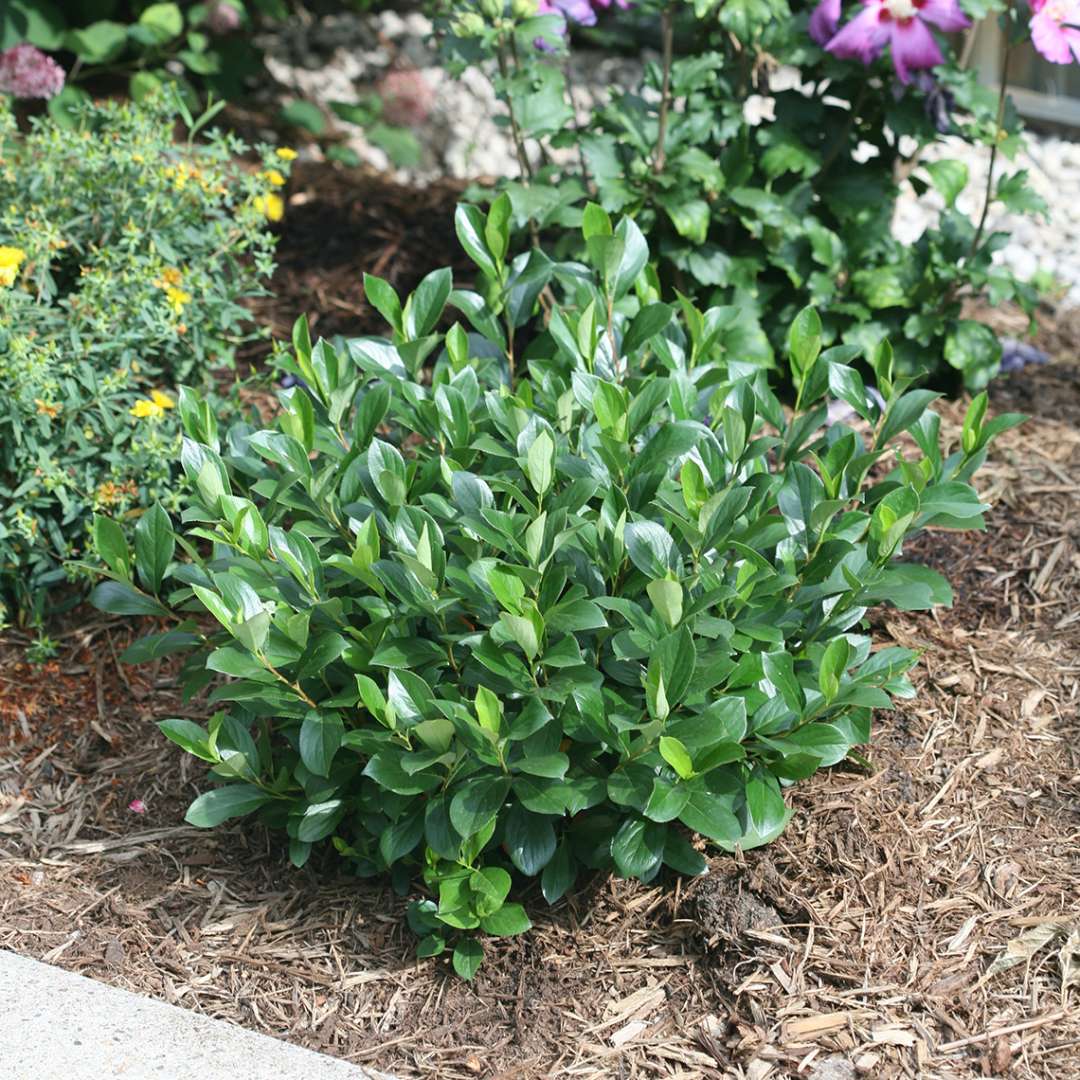 Low Scape Mound aronia from Spring Meadow Nursery
Low Scape Mound aronia from Spring Meadow Nursery 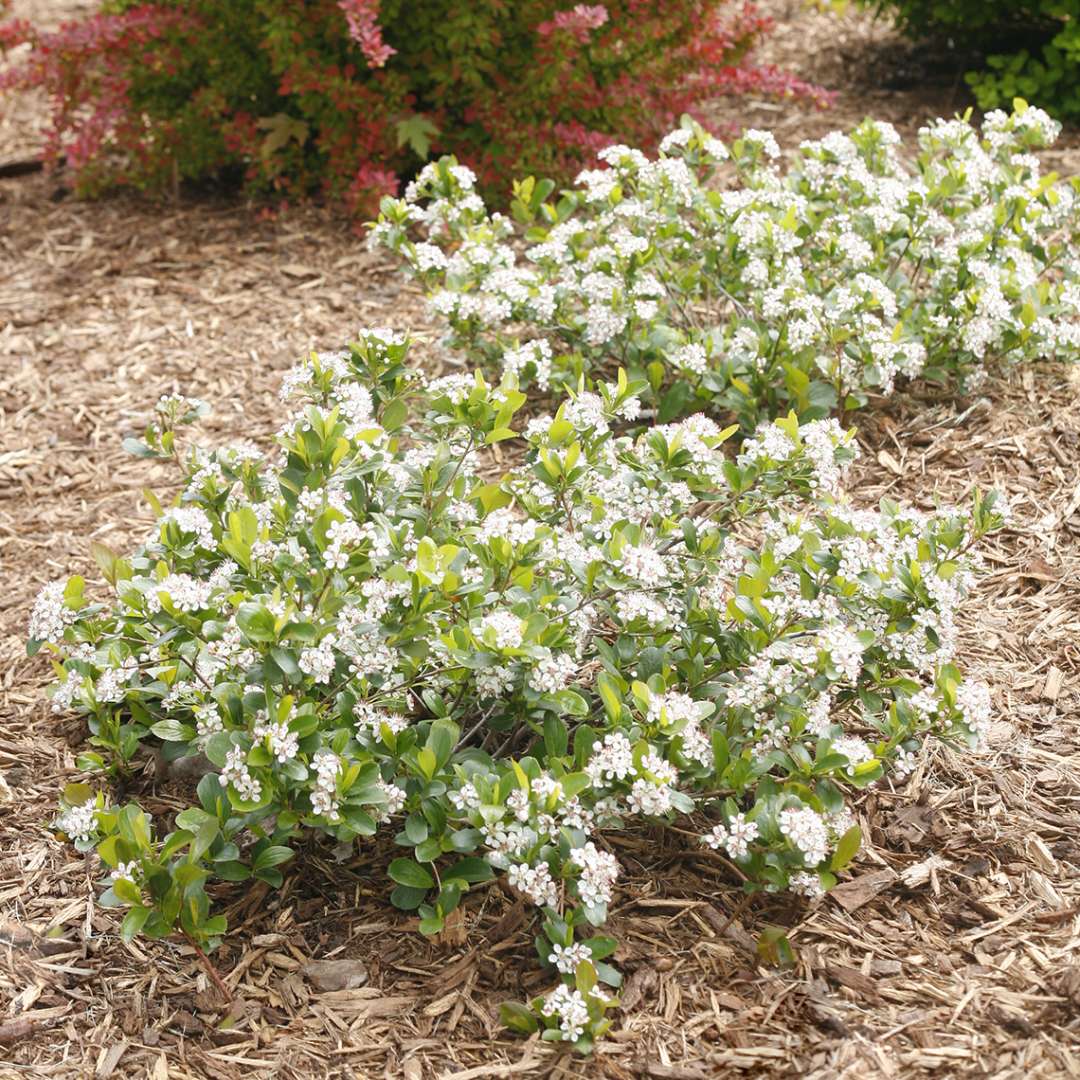 image of aronia Low Scape Mound from Spring Meadow Nursery
image of aronia Low Scape Mound from Spring Meadow Nursery
Lo and Behold Blue Chip Jr. butterfly bush
I love all the small versions of butterfly bush, but the Blue Chip is my fave. You can get ‘Lilac Chip’ (a [ale purple one) ‘Pink Micro Chip’ (a pink one) and “Ice Chip’ (a white one) but I love the purple-blue of this one the best. All these small buddleia (the scientific name for butterfly bush) are around 18-30” tall and spread about 24”. They bloom a LONG time- from summer into fall. They all need full sun (at least 6 hours of direct sunlight) and are hardy to zone 5a. Butterflies and other pollinators love it, and they’re bred specifically to be non-invasive.
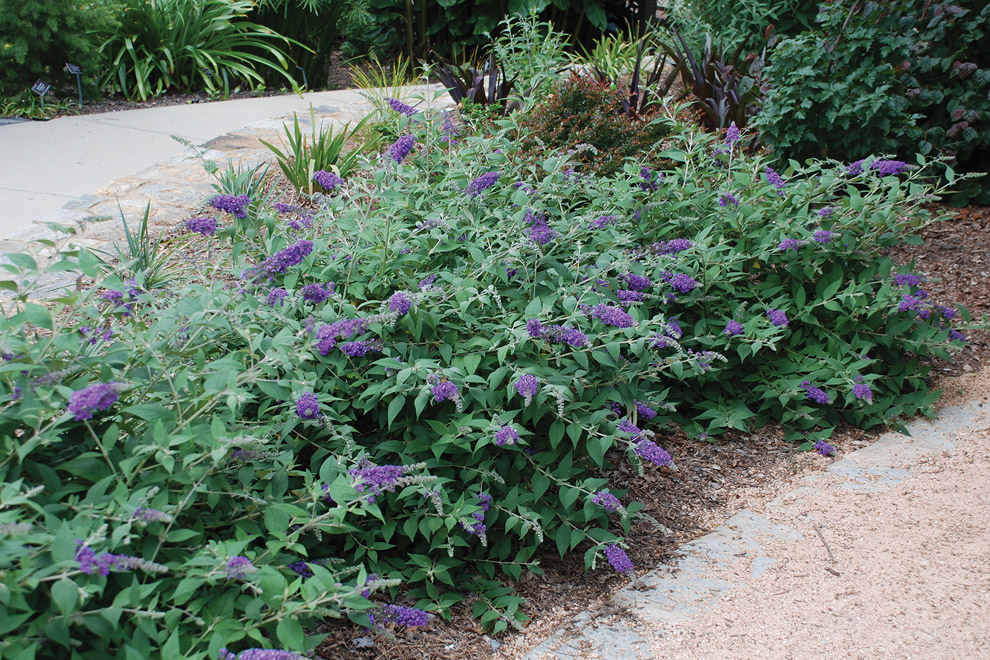 Lo and Behold Blue Chip Jr. butterfly bush from State by State Gardening
Lo and Behold Blue Chip Jr. butterfly bush from State by State Gardening
Deutzia ‘Nikko’, Chardonnay Pearls, and Creme Fraiche
I LOVE all these! Deutzia is this old-fashioned shrub that your grandmother (and maybe her mom) grew. It has gorgeous white flowers in the early summer or late spring. Chardonnay Pearls has bright yellow-green foliage all spring and summer- it totally pops in the springtime. ‘Nikko’ has deep green leaves, while Creme Fraiche has a pale green variegation around the edges. I have found that it’s slow to get started – kinda puny and crispy the first year – but then it grows into its own and doesn’t need anything after that. These mini versions of deutzia get about 20-30” tall and spread about the same. They’re hardy to zone 5a, and make it fine all around Des Moines.
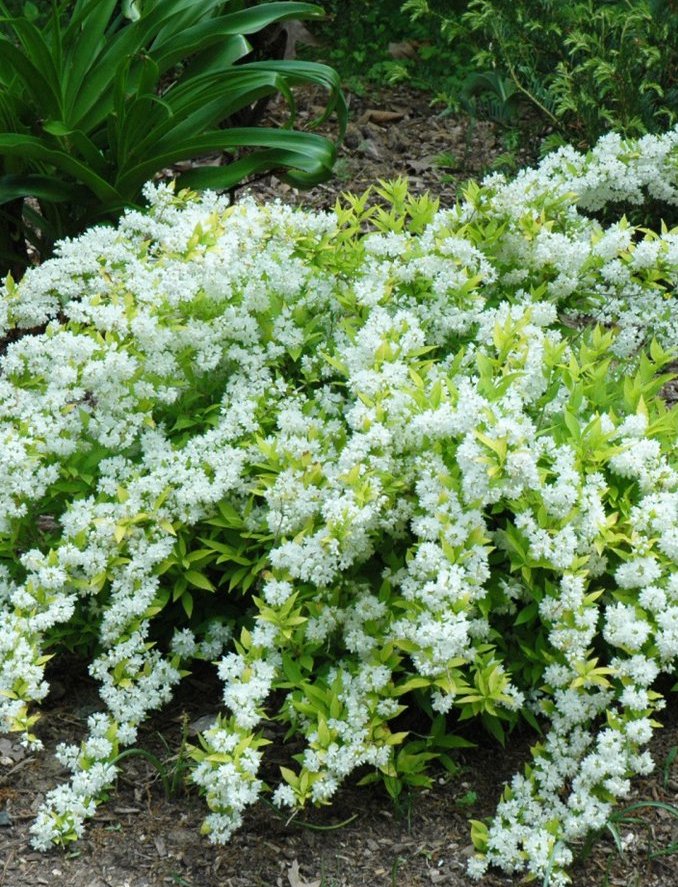 Deutzia photo from Chalet Nursery
Deutzia photo from Chalet Nursery
My Monet weigela
It’s the cutest little bright spot in your yard! My Monet has pink flowers and pink-ish new growth, but the best part is the creamy white variegation around the soft green leaves. It will show up anywhere! Does best in part sun to full sun. Gets about 12-18” tall, and spreads around two feet. Butterflies and other pollinators LOVE the trumpet-shaped flowers! This plant is super tough and hardy to zone 4. It’s fine out in the country at my in-laws’ acreage.
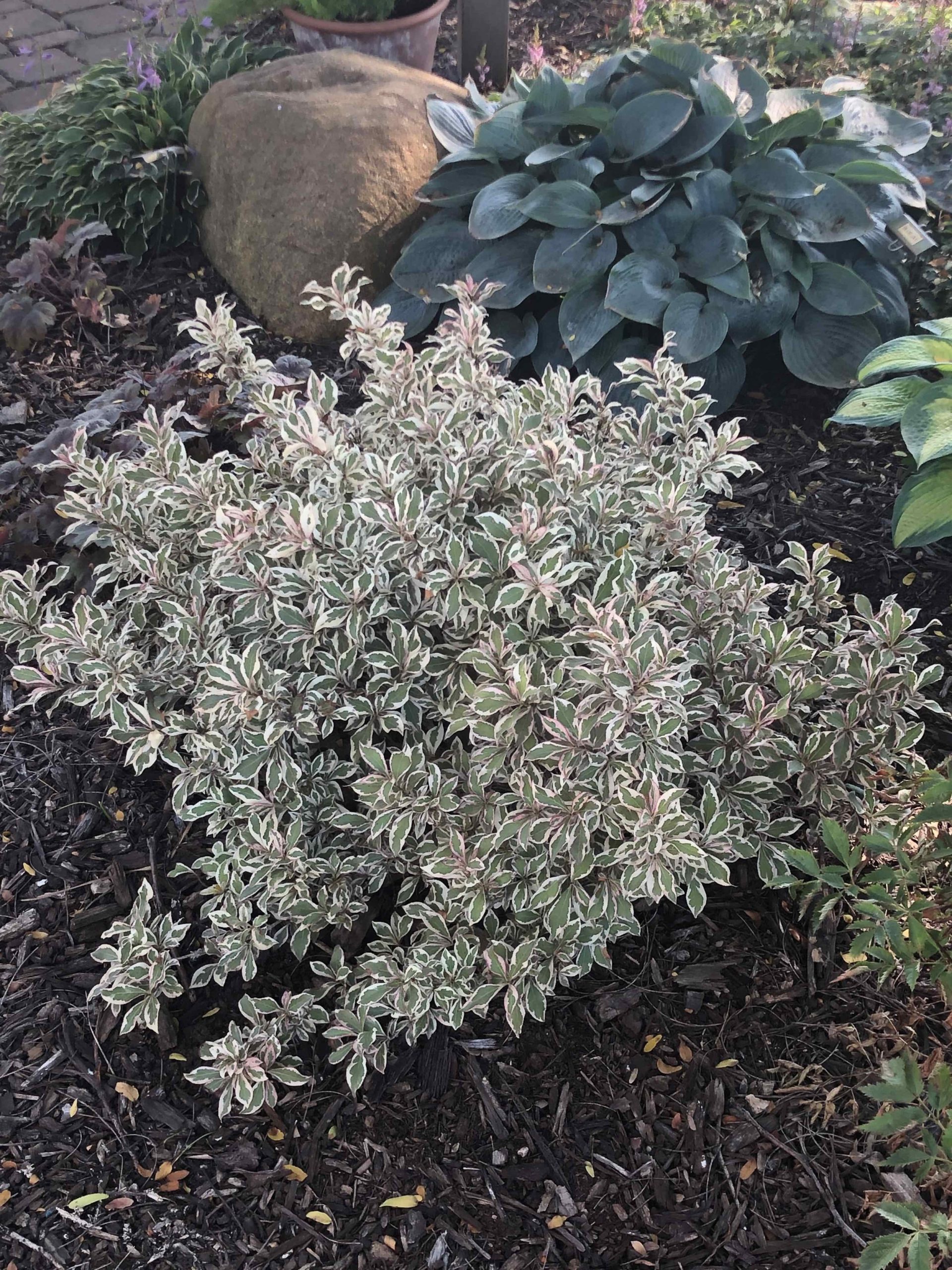 My Monet weigela in my mother-in-law’s gardens
My Monet weigela in my mother-in-law’s gardens
One to avoid:
barberry – it’s invasive like crazy all over the east – in fact, it’s illegal to grow or sell in New England. Birds love to eat the berries and then they get pooped out all over the place, and the plants grow in fast and out-compete native plants in the wild. Yes it’s tough, but there are plenty of other options that have manners. Stick with the list above and leave the barberry alone.
So my best advice for creating a landscape bed that looks finished and intentional is to make sure that your edges are clean and full. Low-growing shrubs will fill in and finish off your edges without asking much of you at all. These babies will be your silver bullet for a great-looking yard! Let me know which one is your favorite!
LIke it
pin it
tweet it
email it